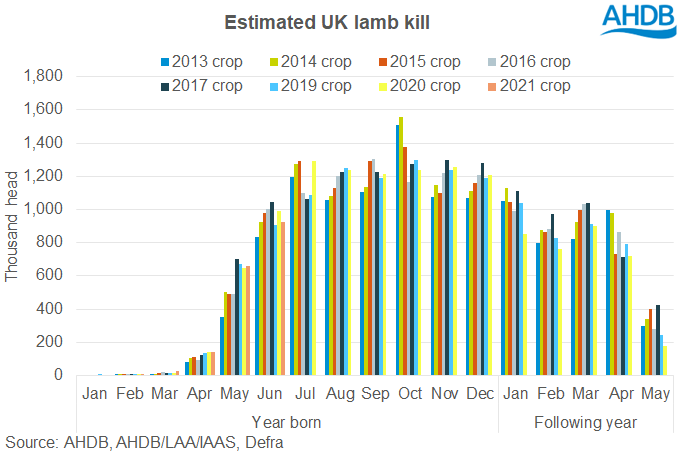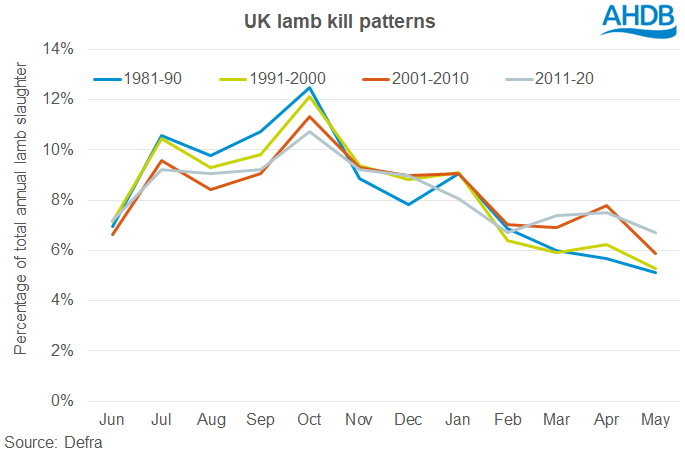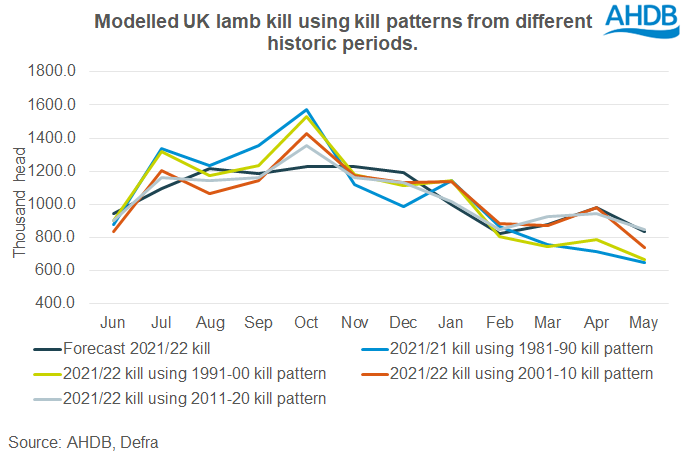Patterns in sheep slaughter: 40 years of change
Thursday, 19 August 2021
By Rebecca Wright
AHDB recently published its latest forecast for the UK sheep market. As well as discussing the apparently low ewe kill levels, changes to UK-EU trade and the future size of the lamb crop, we also talked about lamb kill patterns.
It’s common knowledge that UK sheep meat production peaks in the Autumn, whereas demand peaks at Easter. But has the seasonality of the lamb kill reduced over the years?
For the remainder of this article, please note we will only be looking only at lamb kill.
Data allowing us to spilt out new season lambs and old season lambs from the monthly Defra slaughter data dates back less than 10 years. This limits us in being able to look at kill patterns on a lamb crop basis rather than on a date basis alone.
Considering the large influence weather has on the sheep industry, it is difficult to pick out changes in trends without also being able to attribute them to other major events: the winter storms of 2013-14; the “beast from the east” followed by a heatwave in 2018 and, of course, 2020 and the Covid-19 pandemic alongside the end of the Brexit transition period.
Despite these events, there are a few trends which we can start to see. For example there is an increased number of lambs coming forwards before June in the year of birth, and a flattening and prolonging of peak kill.

If we look at trends pre-2013 than we cannot easily split out the different lamb crops from the monthly data. The UK production year runs from June to May, covering the period when most lambs killed will have come from the same lamb crop. The number of lambs killed is highest through late summer and early autumn before tailing off.

Using the latest forecast figures, we are expecting 12.6 million lambs to be slaughtered between June 2021 and May 2022. Within the forecast we are expecting around 1.2 million lambs to come forwards in October. If however we applied kill patterns recorded in the 1980s then we would have expected almost an additional 350,000 head would come forwards during that month.
Take October for example, using kill patterns from the 1980s we would have expected around 1.57 million lambs (12% of the total kill) to come October whereas using more recent kill patterns we are actually expecting 1.22 million (10%) to come forwards during that month.

The reverse of the above is seen in the spring. In the spring of 2022, we forecast around 200,000 more lambs to come forwards that we would have seen if the kill patterns of the 1980s and 1990s were in place.
So why have kill patterns changed? In part the change will be reflective of changes in the structure of the industry and in consumer demand. In the mid-00s the UK industry underwent massive change with the removal of headage payments. Improvements to productivity will also be playing a part.
Sign up for regular updates
You can subscribe to receive Beef and Lamb market news straight to your inbox. Simply fill in your contact details on our online form.
While AHDB seeks to ensure that the information contained on this webpage is accurate at the time of publication, no warranty is given in respect of the information and data provided. You are responsible for how you use the information. To the maximum extent permitted by law, AHDB accepts no liability for loss, damage or injury howsoever caused or suffered (including that caused by negligence) directly or indirectly in relation to the information or data provided in this publication.
All intellectual property rights in the information and data on this webpage belong to or are licensed by AHDB. You are authorised to use such information for your internal business purposes only and you must not provide this information to any other third parties, including further publication of the information, or for commercial gain in any way whatsoever without the prior written permission of AHDB for each third party disclosure, publication or commercial arrangement. For more information, please see our Terms of Use and Privacy Notice or contact the Director of Corporate Affairs at info@ahdb.org.uk © Agriculture and Horticulture Development Board. All rights reserved.

